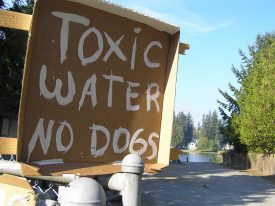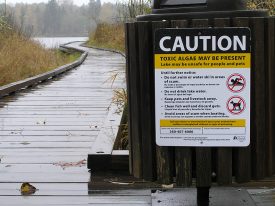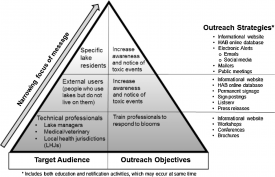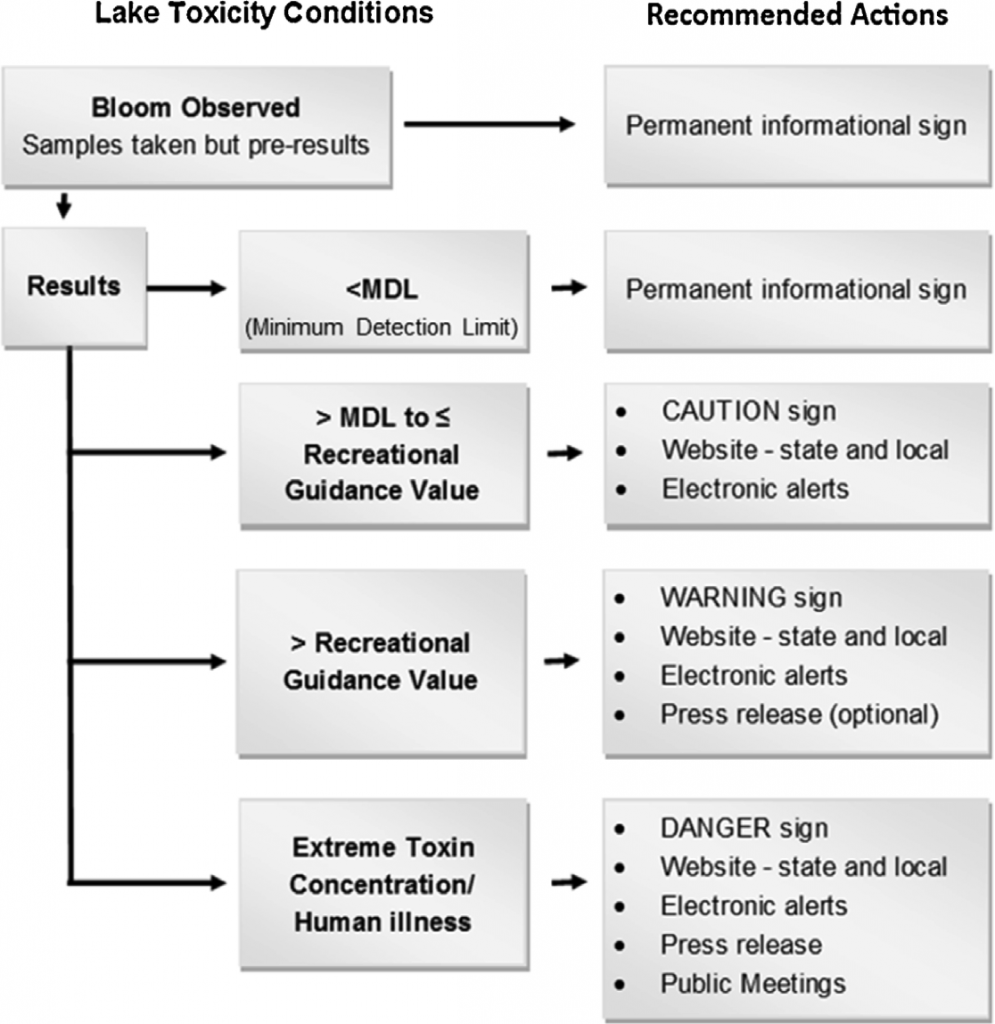by Joan Hardy and Marisa Burghdoff
Blooms of toxin-producing cyanobacteria are on the rise in our lakes and exposure can present a serious health threat to lake users and their pets. To avoid exposure to these harmful algal blooms (HABs), people must be aware of them and of the risk at a particular lake. While numerous strategies have been used to educate and notify the public about HABs, currently there are no national guidelines or suggested outreach approaches. Recently, a team of state and county lake managers in western Washington worked together to implement a number of HAB outreach strategies and assess their effectiveness. Based on their professional experience, the group developed a general framework for HAB outreach along with a specific bloom notification strategy that can help local, state, or other regional groups develop HAB education and notification programs. A summary of key findings is provided for Waterline readers below, but you can see the full published version in Harmful Algae (Hardy et al., 2016; see full citation below).
Background
In 2009, the Washington State Departments of Ecology (Ecology) and Health (DOH) collaborated with King, Pierce, and Snohomish counties to study HABs in 30 lowland lakes in the Puget Sound region. As part of the project, each of the counties and the state tested numerous HAB education and notification strategies ranging from brochures and mailers to social media and press releases. Each agency then evaluated the strategies for their effectiveness with the ultimate goal of having people take actions to reduce risks to themselves and their animals by avoiding exposure to algal toxins. The agency evaluation was coupled with an examination of lake use statistics associated with different levels of one algal toxin, microcystins. Initial analysis of the effectiveness of outreach strategies showed that the number of people using a lake for recreation decreased for all recreational users except pets when outreach was done. Key findings are as follows:
Key Finding #1 – Successful HAB outreach requires a consistent public health message

Figure 1. Before DOH developed signs for toxic algae events, residents at Lake Ketchum, WA, took the initiative to warn pet owners of the risk. Photo – Gene Williams, Snohomish County
Before the project, DOH and Ecology had led the way for HAB outreach by providing a foundational public health message statewide. Washington was one of the first states in the country to develop recreational guidelines identifying specific levels at which algal toxins present a health threat. In addition, the State provided a strong three-tiered advisory posting protocol based on these guidelines for notifying non-residential lake users about the presence of a toxic bloom: basically using CAUTION, WARNING, and DANGER signs in English and Spanish. Furthermore, in 2009 Ecology provided funding for a free testing program for all lake users that provides a mechanism by which lake managers can determine HAB toxicity. These were essential precursors as they provided a recognizable message used throughout the state.

Figure 2. DOH CAUTION, WARNING, and DANGER signs provide clear actions lake users can take to avoid exposure to toxic algae blooms. Photo – Gene Williams, Snohomish County
Key Finding #2 – HAB outreach requires multiple approaches for specific audiences
The most productive HAB outreach involves the simultaneous use of multiple approaches geared toward specific target audiences. The group took the most effective strategies tested and developed a general framework for HAB outreach for both education and notification (Figure 3). The three main target audiences and recommended strategies for each are:
Technical professionals:
Technical professionals are those who need to understand HABs because they may have to respond to public reports of HAB presence or health symptoms as a result of HAB exposure. This group includes local health jurisdiction personnel (LHJ), lake and natural resource managers, and medical and veterinarian professionals. Outreach to LHJs, in particular, is essential to a state or regional outreach program because local environmental health professionals are often the first responders to reports of blooms and may be responsible for posting or closing lakes with HABs. State agencies take the lead in this outreach by hosting workshops and webinars, attending professional conferences, and developing partnerships with veterinarians to reach pet owners.
External lake users:
External or general lake users are those who do not live on lake shores but may be at risk from HAB events when they access lakes through boat launches, public beaches, or parks. At a local level, lake users were best notified through the CAUTION, WARNING, and DANGER signs posted at public access sites per the prescribed notification strategy (Figure 3). A shortcoming of the state-provided signs is that there may be lag time between testing a bloom and posting a lake. One strategy to address this is to post permanent educational signs at lakes with chronic problems as well as notification signs associated with toxicity levels. Other outreach efforts include press releases, which are most valuable when used sparingly for severe blooms or for blooms in large lakes or those with high levels of recreation. At the state level, notification of toxicity test results was especially effective through the web-based HAB database (www.nwtoxicalgae.org) and listserv (join by following instructions on Ecology’s website). The listserv and website are important resources for getting HAB information to the public.
Specific lake residents:
The last target audience is lake residents, people who may be at risk from HAB events because they have homes on lake shorelines or have rights to access the lake through a shared community property. Since lake residents don’t often use public access sites, local notification strategies need to be slightly different for this group. At the local level, lake residents are best notified of toxic incidents through electronic alerts, including email and social media, while mailers to lake residents are useful during initial HAB events and as a way to sign residents up for electronic alerts for lakes with ongoing HAB problems. The state or local websites are also good places for residents to track bloom status.
Key Finding #3 – HAB notification strategies should be tied to lake toxicity conditions
While the general outreach framework described above provides a complete spectrum of education and notification strategies, a more detailed notification strategy (Fig. 4) is presented for professionals focused on the notification portions of HAB outreach for a specific lake or lakes. The notification strategy is based on Washington’s established risk thresholds and provides specific actions to employ for each level.
Next Steps
While this project identified a number of successful outreach strategies, some issues still need to be addressed to improve HAB outreach and notification. A fundamental problem for HAB notification is the lag time between sampling, obtaining test results, and implementing postings or emails. While permanent signage may help improve this problem, rapid testing protocols could also help.
Another approach that could improve HAB outreach is to use and evaluate more extensive social networking. According to a recent report, the internet is now the primary source of science and technology information for most residents, and about 60% of people in the U.S. cite the internet as their main source for science information. Some agencies have not kept pace with technological advances like video and social networking. Using social media like NextDoor, Twitter, blogs, online forums, video sharing and online courses can expand the number of people with access to HAB information and create more opportunities for interaction. There are disadvantages to the internet, though, including lack of access, varying degrees of skills needed to locate and interpret information, and quality of information.
Finally, while this initial assessment of HAB outreach provides a starting point, a more rigorous evaluation with quantitative measures of strategies could certainly be done. Using community-based social marketing (CBSM) could be a valuable way to further develop HAB outreach methods and evaluate their effectiveness.
Information from this effort by WALPA members was published last year:
Hardy, F.J., Bouchard, D., Burghdoff, M., Hanowell, R., LeDoux, B., Preece, E., Tuttle, L., and Williams, G. 2016. Education and notification approaches for harmful algal blooms (HABs), Washington State, USA. Harmful Algae 60:70-80.












